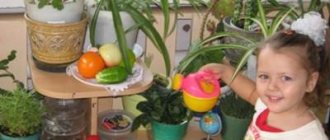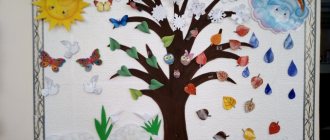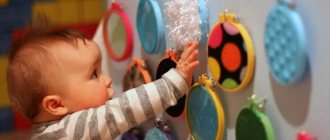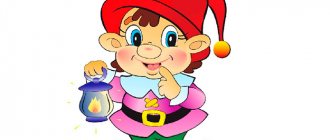Design of a sensory corner in an early age group
Marina Karyakina
Design of a sensory corner in an early age group
The sensory corner is used in the educational process both in organized classes of educators and additional education teachers, and in children’s independent play, search and experimental activities.
The sensory corner in the group is designed:
• to stimulate sensory functions (vision, touch, hearing, taste, smell, tactile sensation)
;
• for the development of fine motor skills, stimulation of motor activity.
• to relieve muscle tension, achieve a state of relaxation and comfortable well-being for children.
• creating a positive emotional background, increasing the child’s performance.
• activation of cognitive processes (thinking, attention, perception, memory)
.
• increasing motivation for independent and experimental activities of preschool children.
Enriching the sensory experience of young children in games and activities with building materials “Enriching the sensory experience of young children in games and activities with building materials” “Theme of generalized pedagogical experience.”
Games for sensory development of children of early and early preschool age The proposed games will help children learn to distinguish colors and name them correctly. Some children have no problems remembering colors (blue, yellow, etc. Competition for the corner of mathematical games and sensory development. Photo report In September, our kindergarten hosted the competition “Corner for Mathematics and Sensory Development.” All groups took an active part. Together with. Summary of educational activities for young children age "It's snowing" in the second group of early age Synopsis of educational activities for young children "It's snowing" Second group of early age Integration of educational areas. Purpose: Creation. Design of a patriotic corner in the group. Our small Motherland, this is the place where we were born. Very important from childhood, instill a sense of pride in one’s people, respect for culture and traditions. Design of a corner of nature in a group Love of nature, communication with it and respect for it contribute to the formation in preschoolers of such character traits as curiosity,. Equipping a corner of sensory education and the development of elementary mathematical concepts (part 1) Part 2 Cognitive development of preschool children in accordance with the Federal State Educational Standard involves the development of curiosity and cognitive motivation, the formation. Equipping a corner for sensory education and the development of elementary mathematical concepts (part 2) Part 1 Dear colleagues, today I would like to continue the story about our Corner for sensory education and the development of elementary mathematical concepts. Parent meeting in an early age group “On the adaptation and moral education of a young child” Dear colleagues, I want to thank you very much and apologize, because I took a lot from you for this meeting. For example, the letter “I.
Source
Organization of the sensorimotor area in the second younger group
Dugushkina E.V. Organization of the sensorimotor area in the second younger group // Sovushka. 2022. N2 (20). URL: https://kssovushka.ru/zhurnal/20/ (access date: 01/03/2022).
Order No. 666543
In September 2022, our kindergarten welcomed a new group of 3-4 year old children. As a result of the diagnostics, it was revealed that the modern child experiences a lack of tactile, auditory, and olfactory sensations. Sometimes he perceives the world around him linearly, one-sidedly. To restore the fullness of perception through interaction with real objects is the main purpose of the sensorimotor corner, created today in many preschool institutions.
It is known that the greater the number of sensory systems involved in the process of raising and educating a child, the more successful and efficient his development occurs. Therefore, in our group we created a sensorimotor corner “The World of Sensory”.
The sensory corner is used in the educational process both in organized classes for teachers and in additional classes, as well as in independent play, search and experimental activities of children.
The sensorimotor corner in the group is intended to:
- to stimulate sensory functions (vision, touch, hearing, taste, smell, tactile sensation);
- for the development of fine motor skills, stimulation of motor activity;
- to relieve muscle and psycho-emotional tension, achieve a state of relaxation and comfortable well-being for children;
- creating a positive emotional background, increasing the child’s performance;
- activation of cognitive processes (thinking, attention, perception, memory);
- increasing motivation for independent and experimental activities of preschool children [1, p.13].
In our group there is a lot of different material for the development of tactile sensations. A large amount of natural material is used: cones, acorns, walnuts, beans, peas and much more. You can make hand massage baths filled with beans and peas. Children play with great pleasure in such baths, at the same time learning the shape, color, and size of objects. Many materials (natural and food) have been dyed in different colors.
Exercises are carried out using corner materials in order to highlight colors and shades in the environment. Children are invited to find in nature (in the kindergarten area, in a group, at home) objects whose color matches the proposed color card. Natural materials for games to develop tactile sensations should also be presented here. The kids like to create compositions from shells and natural materials. Naturally, the work is preceded by a conversation related to plants and seeds. And at the same time, children get acquainted with the properties of many materials, and develop tactile and finger sensations
A large amount of material was collected from various lids.
There is a homemade sensory panel “Seasons”. Children, while developing their hands, simultaneously consolidate knowledge about living and inanimate nature, the sequence of seasons. Based on this panel, educators can implement many didactic games and tasks.
We widely use various cereals, colored in different colors. Children enjoy stringing colorful large pasta onto a thread and making beads for their beloved mother. And how nice it is to plunge your palms into red pearl barley or green rice, complete the teacher’s tasks or look for certain objects.
But most of all, students of our age like to paint with their fingers on trays of semolina.
Basic principles of organizing the sensorimotor area:
- Availability;
- Safety;
- Creativity;
- Diversity of objects [2, pp. 23-24].
Contents of the sensorimotor area in the group:
Vision:
- Glowing cords, all kinds of unusual lamps (unbreakable) that give off reflections, any devices with interesting lighting effects;
- Illusion pictures (rotating spirals, three-dimensional images, etc.);
- Color spots-blots of various shapes;
- Multi-colored translucent scarves;
- Hatching pictures, hide-and-seek pictures;
- Multi-colored hourglasses, iridescent droplets, “perpetual motion machines,” etc.
Hearing:
- Cassettes and discs with sounds: the cries of domestic animals and birds, sounds of transport, sounds of the forest, sounds of water, etc.;
- Devices for creating sounds: rustles, rattles, whistles and other devices that make interesting sounds.
Touch:
- Pieces of fur, fabric, paper, various materials with different textures;
- Items for creating cold and hot (heating pad, ice trays);
- Convex letters, numbers;
- Various cereals in bags, trays for cereals, jars.
Smell:
- Natural, natural smells (coffee, mint, orange peels, etc.)
Taste:
- Cups, molds, plates, skewers for serving children of various tastes [3, p. eleven].
In the fall we tasted various vegetables and fruits.
Joint activities of the teacher and children outside of class in the sensorimotor corner.
- work in coloring books - shading;
- finger gymnastics - lacing;
- games with a constructor - mosaic;
- modeling from clay and plasticine;
- stringing beads;
- colored balls of thread;
- working with scissors.
We will continue this work in the sensorimotor corner we created, because it is very relevant in the development and education of preschool children and gives the children great pleasure! We will regularly update its content.
Literature:
- Karalashvili E.A., Antonenkova O.V. Organization of the sensorimotor corner in a kindergarten group // Directory of a senior teacher. 2008. No. 5.
- Nikitina E. Sensory corners for diagnostics // Hoop. 2006. No. 2.
- Soltseva O.G. Our helpers are the senses // Child in kindergarten. 2007. No. 3.
"World of Sensory" circle
Municipal budgetary preschool educational institution "Kindergarten "Severyanochka"
With. Gorki, Shuryshkarsky district, Yamalo-Nenets Autonomous Okrug
Circle
on the development of sensory standards
in children in the first junior group
Teacher Nadezhda Borisovna Madeeva
The relevance of choosing a topic for a circle
At the present stage, the problem of sensory education has acquired acute resonance. There is an urgent pedagogical need to find effective ways to create pedagogical conditions.
A child’s sensory development is the development of his perception and the formation of ideas about the external properties of objects: shape, color, size, position in space, smell, taste, etc. It is early age that is most favorable for accumulating knowledge about the outside world and improving the functioning of the senses. The developed sensory abilities of a child constitute not only an important precondition for the successful performance of artistic, musical, physical and other types of activities in the future, but also determine the child’s readiness for schooling. Therefore, the importance of a child’s sensory development in early and preschool childhood cannot be overestimated.
Sensory education, aimed at developing a full-fledged perception of the surrounding reality, serves as the basis for knowledge of the world, the first stage of which is sensory experience. The success of mental, physical, and aesthetic education largely depends on the level of sensory development of children, i.e., on how perfectly the child hears, sees, and touches the environment.
Sensory development (from the Latin sensus - feeling, sensation) involves the formation in a child of perception processes and ideas about objects, objects and phenomena of the surrounding world. A baby is born with sensory organs ready to function. But these are only prerequisites for perceiving the surrounding reality. Full sensory development is carried out only in the process of sensory education, when children purposefully form standard ideas about color, shape, size, the signs and properties of various objects and materials, their position in space, etc., all types of perception are developed, thereby laying the foundation for the development of mental activity.
Thus, sensory education creates the necessary prerequisites for the formation of mental functions that are of paramount importance for the possibility of further learning. It is aimed at developing visual, auditory, tactile, kinetic, kinesthetic and other types of sensations and perceptions. Therefore, sensory development, the development of perception and ideas about the external properties of things, plays an important role in the general course of the child’s mental development. In the absence of special sensory education in early and preschool childhood, it proceeds slowly and does not always reach the level required to ensure the further development of the child’s cognitive activity, his successful schooling, and preparation for all types of physical and mental labor, an integral part of which is perception. . This circumstance has led to the need to create a system of sensory education for normally developing preschool children.



